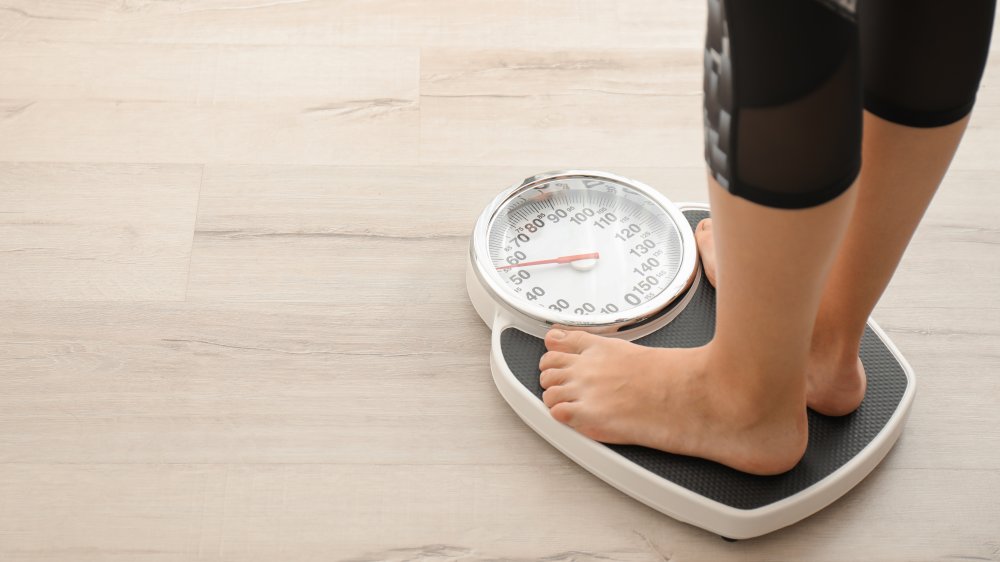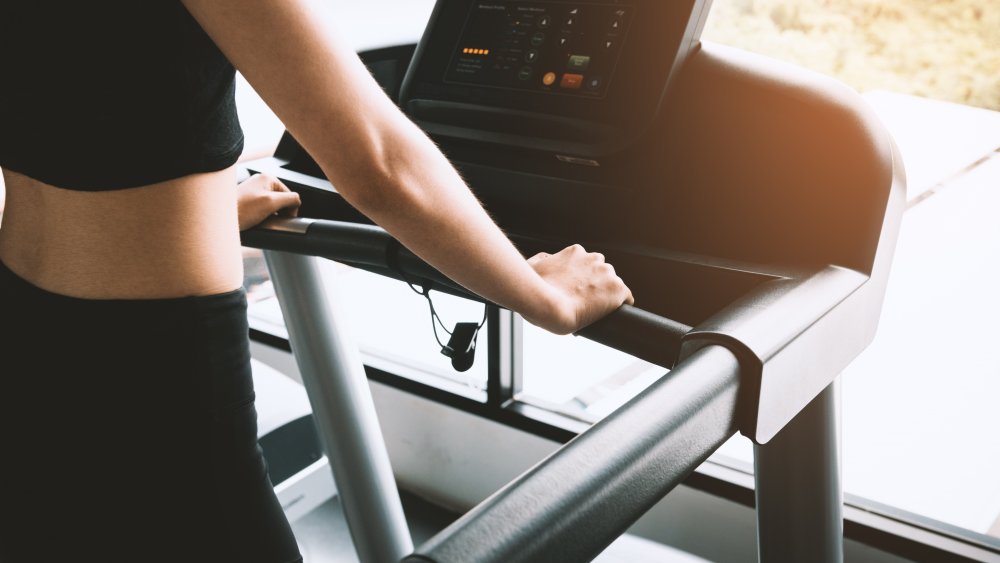When You Use A Treadmill Every Day, This Is What Happens To Your Body
Some people call it the "dreadmill," but what if you love everything about the treadmill you purchased for your home, or it's your favorite piece of equipment at the gym? You love the beeping sound as you push those speed and resistance buttons up and down, the whirring of the belt as it moves gently beneath your feet — maybe you even love the sight of your own sweat droplets on the machine, because they're proof that you are working hard. If you're really smitten with your tread, maybe it's the only kind of workout you want to do. All of those other kinds of non-treadmill workouts — the elliptical, spin class, weight training, even a run or walk outside — might seem boring in comparison.
So is it healthy to use a treadmill every day? "Repeating workouts is not an inherently bad idea, especially if you enjoy what you're doing," Kyle Stull, a National Academy of Sports Medicine-certified trainer and performance enhancement specialist, told Shape. That being said, experts note that when it comes to running or walking on a treadmill, technique is everything. Here is what might happen to your body if you use a treadmill on the daily.
If you use a treadmill every day, you might lose weight
If you and the treadmill first became friends because you were hoping to lose some pounds, you're in luck. The treadmill "can be an extremely effective tool for building aerobic capacity, burning calories, and developing your fitness level," Lee Wratislaw, a Gold's Gym trainer, told PopSugar. But, just stepping on the tread and hitting "start" won't necessarily burn off that pasta you had last night. Both duration and intensity matter. "HIIT [High Intensity Interval Training] sessions, comprised of shorter bursts at higher speeds followed by periods of active recovery or complete rest, are perfect ways to burn more calories in a shorter amount of time," Wratislaw said, adding that a 20 minute session of HIIT is enough to burn serious calories.
What if you'd rather just hit start, choose your preferred speed, and stay there? This technique is called steady state cardio, and to burn sufficient calories, you'll need to run for at least 30 minutes or walk for 40 minutes, according to Wratislaw. How many calories you'll burn depends on your size and your speed. A 30-minute jog at five miles per hour burns 240 calories for a 125-pound person, and someone 185 pounds would burn 355 calories from the identical workout (per Chron). Double that pace and both the lighter and heavier runner would more than double their burn.
If you use a treadmill every day, you could injure yourself
Sure, we've all seen those episodes of Biggest Loser where contestants fall off the treadmill while it's moving ... ouch. Although certainly less dramatic, there are a number of other injuries you could suffer on the treadmill, particularly if you're using it every day. Muscle strain is extremely common, especially if you tend to be a noisy runner, slapping down your feet with an audible thump every time — a sign that you might be flat-footed. "You end up leaning backward as the belt goes forward, which strains back muscles from the force generated through your hips and back," John Higgins, associate professor of medicine at The University of Texas Health Science Center at Houston, told Prevention. Make a conscious effort to strike mid-foot when you land, he advised.
You might also get neck, shoulder, or back pain if you hunch your shoulders when you're walking or running on the treadmill. And if you over stride, where your front foot hits the ground too far in front of you, you indeed could fall off the treadmill, Biggest Loser style (per VeryWellFit). You also risk falling off if, instead of hitting the stop button or gradually slowing down your pace, you try to jump off of it by putting your feet to the sides. "Most people don't have the coordination to do that without risking injury," said Jason Karp, an exercise physiologist (per HuffPost).
If you use a treadmill every day, you might cheat yourself out of a good workout
If your treadmill routine involves reading from your iPad or streaming Netflix, ask yourself: Are you really giving that workout your all? "TV can distract you from mixing things up and shocking the body with speed and incline intervals, which I always recommend to get the most efficient workout in," Greg Justice, an exercise physiologist at AYC Health & Fitness in Kansas City, told Women's Health.
You could also be cheating yourself out of a good workout if you hold on to the rail or bars while you're walking or running, which is more likely to happen if you've set the incline too high or the speed too fast, Karp said. Even if you're not guilty of rail-holding, or tuning out to TV, you still not be getting 100 percent from your treadmill routine if you're always choosing the exact same speeds, duration, and incline, according to Karp. "One of the biggest mistakes people make [at the gym] is to do the exact same thing every time, and then wonder why they don't see results," he said.
If you use a treadmill every day, you could develop perfect runner's form
Running outside might feel more freeing than running on a treadmill — the wind in your hair, the sun on your face — but terrain shifts and weather conditions can do a number on your form. The cold weather can make your muscles tense, and you could lean forward due to wind or hills. On a treadmill, by comparison, the speed, incline and climate are all completely within your control. That's likely why a study found that treadmill runners have reduced stride lengths and higher stride frequencies compared to outdoor runners (per Runner's World). Both of these qualities result in more efficient running form.
Plus, without distractions from the outdoors, you can really focus your effort on that relaxed sway of your arms at 90-degree angles and striking mid-foot. Bottom line: Treadmills are a smart way to perfect your running form and correct any mistakes, noted The Run Experience.




